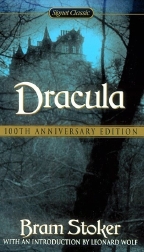Dracula
Bram Stoker
Signet
US Mass Market Paperback
ISBN 0-451-52337-7
Publication Date: 10-01-1997
382 pages ; $4.95
Review Date: April 4, 2003
Reviewed by: Katie Dean © 2003

REFERENCES
COLUMNS
|
|
|
DraculaBram StokerSignetUS Mass Market PaperbackISBN 0-451-52337-7Publication Date: 10-01-1997382 pages ; $4.95Review Date: April 4, 2003Reviewed by: Katie Dean © 2003 |
|
|
REFERENCES |
COLUMNS |
Bram Stoker's 'Dracula' is a classic horror story that needs no introduction. Published in 1897, it has been turned into films, produced on stage and inspired generations of authors to write their own vampire tales. There can be few people who do not know the story of Count Dracula, but how many have actually read Stoker's novel? Despite its nineteenth-century origins, 'Dracula' is extremely readable and far surpasses much modern horror fiction for its chilling atmosphere and thrilling climax. For all that, it is also very much a product of its age and hides a fascinating subtext, a protest against sexual immorality
The story of Count Dracula is told through the eyes of its participants via diaries, letters and newspaper articles. The only major character from whom we do not hear in person is the Count himself. Told in the first person in this manner, the full horror of events comes across more strongly than a re-telling by a third person, be it author or fictional narrator. However, in choosing this method, Stoker sets himself the task of injecting multiple characters into the prose. The effect is excellent: the slightly gossipy letters between Mina Harker and Lucy Westenra clearly differ from the scientific journal of Dr Seward or the personal diary of Jonathan Harker. Through these differing styles we sense the changing moods of confusion, curiosity and fear.
Stoker also uses multiple settings - Transylvania, London, Whitby - to great effect. The book opens in Transylvania where everything speaks of horror. The weather is dark and stormy, Jonathan Harker receives mysterious warnings from fearful peasants and wolves are seen as dark shadows flitting across the landscape. The classic ingredients of a horror story are here in abundance. The feeling of hidden fears, a sense of something terrible about to happen, increases inside Castle Dracula, building to a disturbing climax within the first few chapters of the book. The story becomes perhaps more chilling in the scenes set in England. Stoker juxtaposes the growing presence of evil against people living very ordinary lives, completely unaware of what is about to befall them. Even the mental asylum appears relatively normal until the presence of Count Dracula is felt. It is the way in which scenes are set as much as the events themselves that make the difference between a truly chilling horror story and a series of rather unpleasant events told in a manner that appears in bad taste or even so unlikely as to be laughable. Bram Stoker describes a series of truly chilling scenes with a feeling of suspense that never disappears.
Aside from its obvious merits as a horror story, 'Dracula' is also a fascinating comment on its time. The vampire myth has preoccupied writers before and since 'Dracula' appeared. Many centuries ago, vampires and werewolves were really thought to exist. Just as people were tried as witches in Europe and America, so bodies were dug up and freed from their 'undead' state by driving a stake through the heart. Peasants used charms to protect themselves and their livestock from the marauding undead. All these elements of legend appear in 'Dracula', but Stoker's vampires also possess a strong sexuality. The three she-vampires that prey on Jonathan in Castle Dracula are overtly seductive. Jonathan is at the same time petrified and almost uncontrollably tempted by them. Count Dracula himself is cleverly portrayed with a human element. He is not simply a monster, but also possesses a certain charm and masculinity which makes him irresistible. Lucy Westenra also experiences a mixture of terror and fascination when attacked by the Count. It is no coincidence that Lucy, Dracula's first and only conquest is portrayed as being extremely attractive to men. It is Lucy's three suitors who hunt down and destroy Dracula. The subtext of 'Dracula' is about sexual morality. In Stoker's world, sex is a temptation that is almost irresistible, but must be avoided or the consequences will be dire. This message had a huge appeal for a late Victorian audience and provides an insight into a previous era, however unfashionable it may be today.
All these elements make 'Dracula' a horror masterpiece, a classic story that still holds as much fascination today as when originally published. It is a truly great book, worth reading even though the story is so well known.